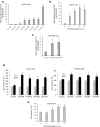Ascites IL-10 Promotes Ovarian Cancer Cell Migration
- PMID: 30039195
- PMCID: PMC6250615
- DOI: 10.1007/s12307-018-0215-3
Ascites IL-10 Promotes Ovarian Cancer Cell Migration
Abstract
Ovarian cancer (OC) ascites is an inflammatory and immunosuppressive tumor environment characterized by the presence of various cytokines, chemokines and growth factors. The presence of high concentrations of these cytokines/chemokines in ascites is associated with a more aggressive tumor phenotype. IL-10 is an immunosuppressive cytokine for which high expression has been associated with poor prognosis in some cancers. However, its role on OC tumor cells has not been explored. Therefore, the aim of the current study was to elucidate the role of ascites IL-10 on the proliferation, migration and survival of OC cell lines. Here, we show that IL-10 levels are markedly increased in patients with advanced serous OC ascites relative to serous stage I/II ascites and peritoneal effusions from women with benign conditions. Ascites and IL-10 dose-dependently enhanced the proliferation and migration of OC cell lines CaOV3 and OVCAR3 but had no effect on cell survival. IL-10 levels in ascites positively correlated with the ability of ascites to promote cell migration but not proliferation. Depletion of IL-10 from ascites markedly inhibited ascites-induced OC cell migration but was not crucial for ascites-mediated cell proliferation. Taken together, our findings establish an important role for IL-10, as a component of ascites, in the migration of tumor cells.
Keywords: Ascites; Cell migration; Cell proliferation; IL-10; Ovarian carcinoma.
Conflict of interest statement
The authors declare that they have no competing interests.
Figures





References
Grants and funding
LinkOut - more resources
Full Text Sources
Other Literature Sources

